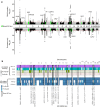Integration of GWAS, QTLs and keratinocyte functional assays reveals molecular mechanisms of atopic dermatitis
- PMID: 40164604
- PMCID: PMC11958703
- DOI: 10.1038/s41467-025-58310-7
Integration of GWAS, QTLs and keratinocyte functional assays reveals molecular mechanisms of atopic dermatitis
Abstract
Atopic dermatitis is a highly heritable and common inflammatory skin condition affecting children and adults worldwide. Multi-ancestry approaches to atopic dermatitis genetic association studies are poised to boost power to detect genetic signal and identify loci contributing to atopic dermatitis risk. Here, we present a multi-ancestry GWAS meta-analysis of twelve atopic dermatitis cohorts from five ancestral populations totaling 56,146 cases and 602,280 controls. We report 101 genomic loci associated with atopic dermatitis, including 16 loci that have not been previously associated with atopic dermatitis or eczema. Fine-mapping, QTL colocalization, and cell-type enrichment analyses identified genes and cell types implicated in atopic dermatitis pathophysiology. Functional analyses in keratinocytes provide evidence for genes that could play a role in atopic dermatitis through epidermal barrier function. Our study provides insights into the etiology of atopic dermatitis by harnessing multiple genetic and functional approaches to unveil the mechanisms by which atopic dermatitis-associated variants impact genes and cell types.
© 2025. The Author(s).
Conflict of interest statement
Competing interests: B.R.G., M.O., K.M.S. are employees of AbbVie. F.T. and C.H. were employees of AbbVie at the time of the study. J.E.G. (University of Michigan) has received research support from AbbVie, Janssen, Almirall, Prometheus Biosciences/Merck, BMS/Celgene, Boehringer Ingelheim, Galderma, Eli Lilly, and advisor to Sanofi, Eli Lilly, Galderma, BMS, Boehringer Ingelheim. M.K.S., R.U., M.T.P., Q.L., R.B., J.M.K., L.C.T. are employees of University of Michigan and have no funding to disclose. M.E.M., A.H.S., F.D.M., D.W., J.T.G, L.Y., H.V., H.H. are employees of the Children’s Hospital of Philadelphia and have no funding to disclose. The design, study conduct, and financial support for this research were provided by AbbVie. AbbVie participated in the interpretation of data, review, and approval of the publication.
Figures






References
Publication types
MeSH terms
Grants and funding
LinkOut - more resources
Full Text Sources

